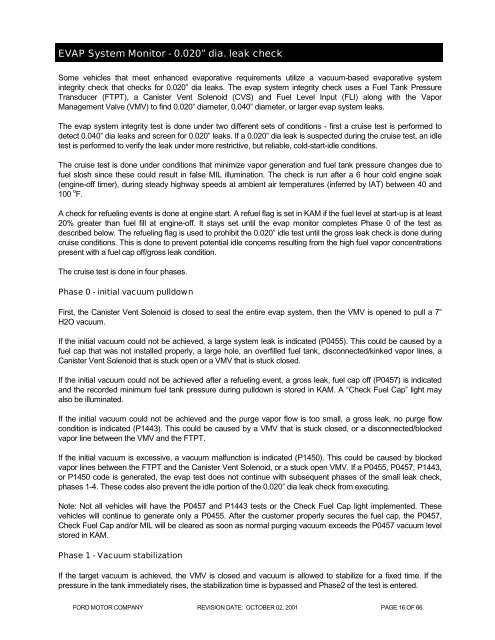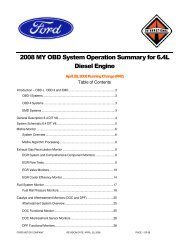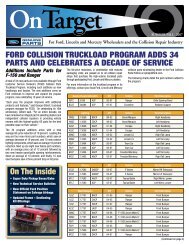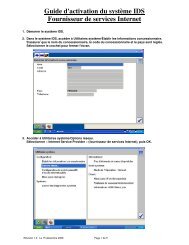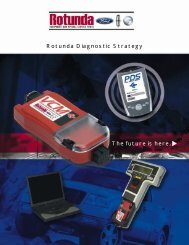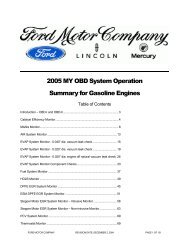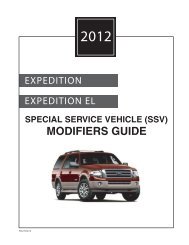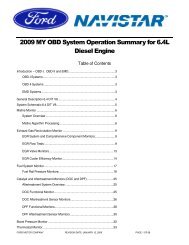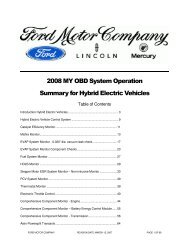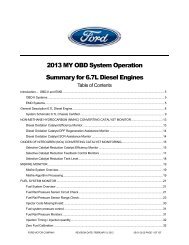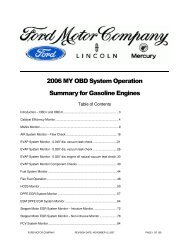2002 MY OBD-II System Operation Summary - MotorCraftService.com
2002 MY OBD-II System Operation Summary - MotorCraftService.com
2002 MY OBD-II System Operation Summary - MotorCraftService.com
Create successful ePaper yourself
Turn your PDF publications into a flip-book with our unique Google optimized e-Paper software.
EVAP <strong>System</strong> Monitor - 0.020” dia. leak checkSome vehicles that meet enhanced evaporative requirements utilize a vacuum-based evaporative systemintegrity check that checks for 0.020” dia leaks. The evap system integrity check uses a Fuel Tank PressureTransducer (FTPT), a Canister Vent Solenoid (CVS) and Fuel Level Input (FLI) along with the VaporManagement Valve (VMV) to find 0.020” diameter, 0.040” diameter, or larger evap system leaks.The evap system integrity test is done under two different sets of conditions - first a cruise test is performed todetect 0.040” dia leaks and screen for 0.020” leaks. If a 0.020” dia leak is suspected during the cruise test, an idletest is performed to verify the leak under more restrictive, but reliable, cold-start-idle conditions.The cruise test is done under conditions that minimize vapor generation and fuel tank pressure changes due tofuel slosh since these could result in false MIL illumination. The check is run after a 6 hour cold engine soak(engine-off timer), during steady highway speeds at ambient air temperatures (inferred by IAT) between 40 and100 o F.A check for refueling events is done at engine start. A refuel flag is set in KAM if the fuel level at start-up is at least20% greater than fuel fill at engine-off. It stays set until the evap monitor <strong>com</strong>pletes Phase 0 of the test asdescribed below. The refueling flag is used to prohibit the 0.020” idle test until the gross leak check is done duringcruise conditions. This is done to prevent potential idle concerns resulting from the high fuel vapor concentrationspresent with a fuel cap off/gross leak condition.The cruise test is done in four phases.Phase 0 - initial vacuum pulldownFirst, the Canister Vent Solenoid is closed to seal the entire evap system, then the VMV is opened to pull a 7”H2O vacuum.If the initial vacuum could not be achieved, a large system leak is indicated (P0455). This could be caused by afuel cap that was not installed properly, a large hole, an overfilled fuel tank, disconnected/kinked vapor lines, aCanister Vent Solenoid that is stuck open or a VMV that is stuck closed.If the initial vacuum could not be achieved after a refueling event, a gross leak, fuel cap off (P0457) is indicatedand the recorded minimum fuel tank pressure during pulldown is stored in KAM. A “Check Fuel Cap” light mayalso be illuminated.If the initial vacuum could not be achieved and the purge vapor flow is too small, a gross leak, no purge flowcondition is indicated (P1443). This could be caused by a VMV that is stuck closed, or a disconnected/blockedvapor line between the VMV and the FTPT.If the initial vacuum is excessive, a vacuum malfunction is indicated (P1450). This could be caused by blockedvapor lines between the FTPT and the Canister Vent Solenoid, or a stuck open VMV. If a P0455, P0457, P1443,or P1450 code is generated, the evap test does not continue with subsequent phases of the small leak check,phases 1-4. These codes also prevent the idle portion of the 0.020” dia leak check from executing.Note: Not all vehicles will have the P0457 and P1443 tests or the Check Fuel Cap light implemented. Thesevehicles will continue to generate only a P0455. After the customer properly secures the fuel cap, the P0457,Check Fuel Cap and/or MIL will be cleared as soon as normal purging vacuum exceeds the P0457 vacuum levelstored in KAM.Phase 1 - Vacuum stabilizationIf the target vacuum is achieved, the VMV is closed and vacuum is allowed to stabilize for a fixed time. If thepressure in the tank immediately rises, the stabilization time is bypassed and Phase2 of the test is entered.FORD MOTOR COMPANY REVISION DATE: OCTOBER 02, 2001 PAGE 16 OF 66


